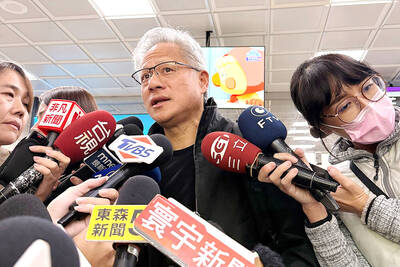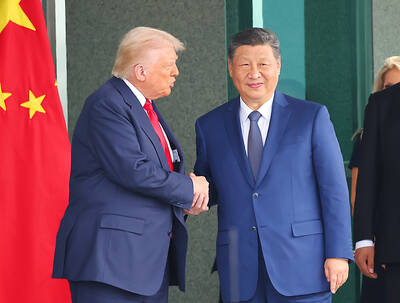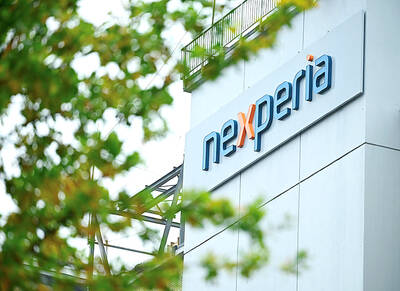Wistron Corp (緯創), one of Taiwan’s leading computer and peripheral original design manufacturers (ODM), reported yesterday a first-half gross profit increase of 50 percent to NT$11.01 billion (US$350 million).
The company attributed the increase to strong shipments of notebooks and liquid-crystal displays (LCD). However, Wistron also warned of slower shipment growth of about 20 percent in the third quarter, falling to below 10 percent by the fourth quarter.
The firm’s current customer base includes large computer firms such as Dell Inc, Hewlett-Packard Co, Microsoft Corp and Sony Corp. Wistron’s product line consists of notebook computers, desktop PCs, servers, personal digital assistants and LCD TVs.
Wistron, once part of the design, manufacturing and services unit of Acer Inc (宏碁), was spun off in 2001. Earlier in the year, Wistron agreed to purchase the computer monitor business of Lite-On Technology Corp (光寶) for NT$9.2 billion.
“The business situation is in line with [our] original planning. The merger with Lite-On Technology will shift operating margins down slightly. Our second half margin projection is around 5.5 percent,” said Simon Lin (林憲銘), Wistron chairman and chief executive officer, during an investors’ conference yesterday.
Consolidated first-half revenue came in at NT$178.89 billion, an increase of 62 percent as operating income reached NT$3.63 billion, a 27 percent increase. Earnings before tax and after tax were NT$3.87 billion and NT$3.11 billion respectively, producing earnings per share of NT$2.55.
Factoring in employee bonuses, second-quarter revenue increased by 6.08 percent quarter-to-quarter to NT$92.09 billion. Pre-tax and after-tax earnings were NT$1.75 billion and NT$1.43 billion respectively, producing an earnings per share figure of NT$1.04.
Lin also addressed the potential issuing of global depository receipts (GDRs).
“We still need to evaluate the business outlook for 2009. If we maintain 30 percent growth, we can use our current balance sheet to run the business. If we go above 30 percent, then we will decide on the possibility of issuing GDRs later this year or early next year. The size of the issue will equal approximately 20 percent dilution,” he said.
The board also approved a capital injection of of 155 million Czech crowns (US$10 million) into its subsidiary, Wistron InfoComm, which is based in the Czech Republic.
Wistron closed up 5.4 percent at NT$48.10 on the Taiwan Stock Exchange yesterday. The stock is down 20 percent in the year to date.

Nissan Motor Co has agreed to sell its global headquarters in Yokohama for ¥97 billion (US$630 million) to a group sponsored by Taiwanese autoparts maker Minth Group (敏實集團), as the struggling automaker seeks to shore up its financial position. The acquisition is led by a special purchase company managed by KJR Management Ltd, a Japanese real-estate unit of private equity giant KKR & Co, people familiar with the matter said. KJR said it would act as asset manager together with Mizuho Real Estate Management Co. Nissan is undergoing a broad cost-cutting campaign by eliminating jobs and shuttering plants as it grapples

PERSISTENT RUMORS: Nvidia’s CEO said the firm is not in talks to sell AI chips to China, but he would welcome a change in US policy barring the activity Nvidia Corp CEO Jensen Huang (黃仁勳) said his company is not in discussions to sell its Blackwell artificial intelligence (AI) chips to Chinese firms, waving off speculation it is trying to engineer a return to the world’s largest semiconductor market. Huang, who arrived in Taiwan yesterday ahead of meetings with longtime partner Taiwan Semiconductor Manufacturing Co (TSMC, 台積電), took the opportunity to clarify recent comments about the US-China AI race. The Nvidia head caused a stir in an interview this week with the Financial Times, in which he was quoted as saying “China will win” the AI race. Huang yesterday said

TEMPORARY TRUCE: China has made concessions to ease rare earth trade controls, among others, while Washington holds fire on a 100% tariff on all Chinese goods China is effectively suspending implementation of additional export controls on rare earth metals and terminating investigations targeting US companies in the semiconductor supply chain, the White House announced. The White House on Saturday issued a fact sheet outlining some details of the trade pact agreed to earlier in the week by US President Donald Trump and Chinese President Xi Jinping (習近平) that aimed to ease tensions between the world’s two largest economies. Under the deal, China is to issue general licenses valid for exports of rare earths, gallium, germanium, antimony and graphite “for the benefit of US end users and their suppliers

Dutch chipmaker Nexperia BV’s China unit yesterday said that it had established sufficient inventories of finished goods and works-in-progress, and that its supply chain remained secure and stable after its parent halted wafer supplies. The Dutch company suspended supplies of wafers to its Chinese assembly plant a week ago, calling it “a direct consequence of the local management’s recent failure to comply with the agreed contractual payment terms,” Reuters reported on Friday last week. Its China unit called Nexperia’s suspension “unilateral” and “extremely irresponsible,” adding that the Dutch parent’s claim about contractual payment was “misleading and highly deceptive,” according to a statement